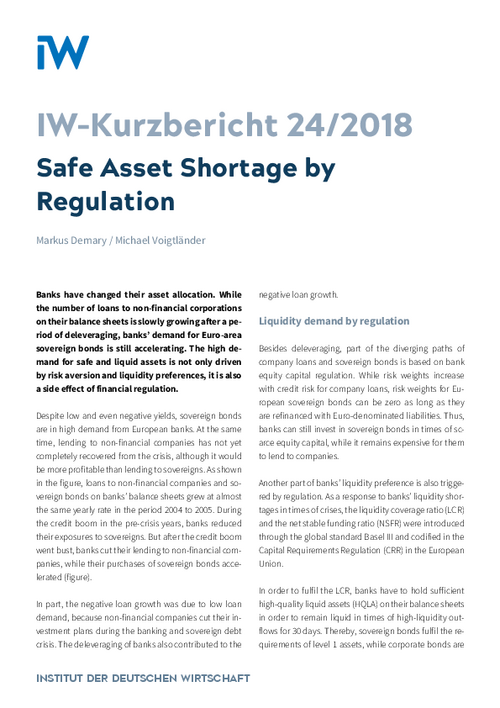Banks have changed their asset allocation. While the number of loans to non-financial corporations on their balance sheets is slowly growing after a period of deleveraging, banks’ demand for Euro-area sovereign bonds is still accelerating. The high demand for safe and liquid assets is not only driven by risk aversion and liquidity preferences, it is also a side effect of financial regulation.

Safe Asset Shortage by Regulation
IW-Kurzbericht

Banks have changed their asset allocation. While the number of loans to non-financial corporations on their balance sheets is slowly growing after a period of deleveraging, banks’ demand for Euro-area sovereign bonds is still accelerating. The high demand for safe and liquid assets is not only driven by risk aversion and liquidity preferences, it is also a side effect of financial regulation.
Despite low and even negative yields, sovereign bonds are in high demand from European banks. At the same time, lending to non-financial companies has not yet completely recovered from the crisis, although it would be more profitable than lending to sovereigns. As shown in the figure, loans to non-financial companies and sovereign bonds on banks’ balance sheets grew at almost the same yearly rate in the period 2004 to 2005. During the credit boom in the pre-crisis years, banks reduced their exposures to sovereigns. But after the credit boom went bust, banks cut their lending to non-financial companies, while their purchases of sovereign bonds accelerated (figure).
In part, the negative loan growth was due to low loan demand, because non-financial companies cut their investment plans during the banking and sovereign debt crisis. The deleveraging of banks also contributed to the negative loan growth.
Liquidity demand by regulation
Besides deleveraging, part of the diverging paths of company loans and sovereign bonds is based on bank equity capital regulation. While risk weights increase with credit risk for company loans, risk weights for European sovereign bonds can be zero as long as they are refinanced with Euro-denominated liabilities. Thus, banks can still invest in sovereign bonds in times of scarce equity capital, while it remains expensive for them to lend to companies.
Another part of banks’ liquidity preference is also triggered by regulation. As a response to banks’ liquidity shortages in times of crises, the liquidity coverage ratio (LCR) and the net stable funding ratio (NSFR) were introduced through the global standard Basel III and codified in the Capital Requirements Regulation (CRR) in the European Union.
In order to fulfil the LCR, banks have to hold sufficient high-quality liquid assets (HQLA) on their balance sheets in order to remain liquid in times of high-liquidity outflows for 30 days. Thereby, sovereign bonds fulfil the requirements of level 1 assets, while corporate bonds are level 2 assets, which have an upper cap of 40 percent of the stock of HQLA. Moreover, level 1 assets are not subject to a haircut, while level 2 assets are subject to a haircut of at least 15 percent (BCBS, 2013).

Markus Demary / Michael Voigtländer: Safe Asset Shortage by Regulation
IW-Kurzbericht

More on the topic

Strengthened competition in payment services
Starting on January 13, 2018, the Second Payment Services Directive (PSD2) will apply in the European Union. Among other things, the Directive’s aim is to adapt regulation to the innovations in payment services and to promote the Single Market for non-cash ...
IW
An EU comparison: The structure of consumer spending
The purchasing power of EU consumers varies considerably. This is also reflected by the structure of households’ expenditure. The share of food in consumer spending is highest in Romania, one of the countries with the lowest per capita income. On the other ...
IW